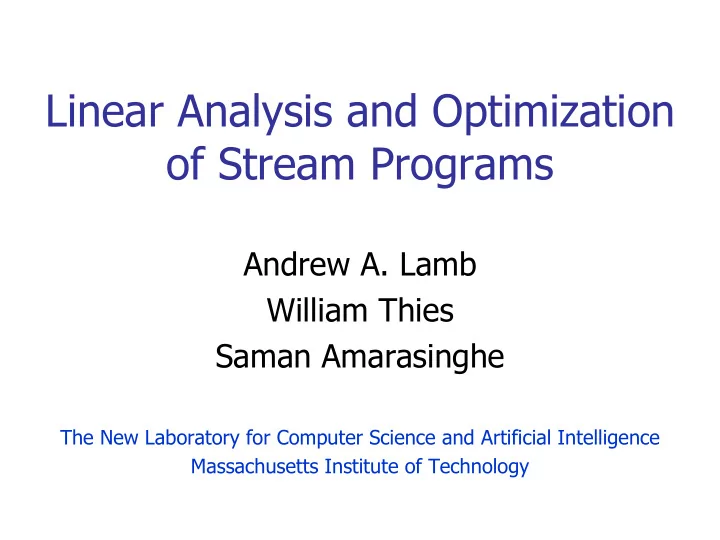

Linear Analysis and Optimization of Stream Programs Andrew A. Lamb William Thies Saman Amarasinghe The New Laboratory for Computer Science and Artificial Intelligence Massachusetts Institute of Technology
Streaming Application Domain � Based on audio, video, or data stream � Increasingly prevalent and important � Embedded systems � Cell phones, handheld computers � Desktop applications � Streaming media • Real-time encryption � Software radio • Graphics packages � High-performance servers � Software routers (Example: Click) � Cell phone base stations � HDTV editing consoles The New Laboratory for Computer Science and Artificial Intelligence Massachusetts Institute of Technology
Properties of Stream Programs � A large (possibly infinite) amount of data � Limited lifetime of each data item � Little processing of each data item � Computation: apply multiple filters to data � Each filter takes an input stream, does some processing, and produces an output stream � Filters are independent and self-contained � A regular, static computation pattern � Filter graph is relatively constant � A lot of opportunities for compiler optimizations The New Laboratory for Computer Science and Artificial Intelligence Massachusetts Institute of Technology
The StreamIt Language � Goals: � Provide a High-Level Programming Paradigm � Improve Programmer Productivity � Match Performance of Hand-Hacked Assembly � Contributions � Language Design, Structured Streams, Buffer Management (CC 2002) � Exploiting Wire-Exposed Architectures (ASPLOS 2002) � Scheduling of Static Dataflow Graphs (LCTES 2003) � Domain Specific Optimizations (PLDI 2003) The New Laboratory for Computer Science and Artificial Intelligence Massachusetts Institute of Technology
Example: Freq band detection � Used in… � metal detector A/D � garage door opener Band pass � spectrum analyzer Duplicate Detect Detect Detect Detect Source: LED LED LED LED Application Report SPRA414 Texas Instruments, 1999 The New Laboratory for Computer Science and Artificial Intelligence Massachusetts Institute of Technology
Freq band detection in StreamIt void->void pipeline FrequencyBand { float sFreq = 4000; float cFreq = 500/(sFreq*2*pi); float wFreq = 100/(sFreq*2*pi); A/D add D2ASource(sFreq); add BandPassFilter(1, cFreq-wFreq, Band pass cFreq+wFreq, 100); add splitjoin { Duplicate split duplicate; for (int i=0; i<4; i++) { Detect Detect Detect Detect add Detector(i/4); LED add LEDOutput(i); LED LED LED } join roundrobin(0); } } The New Laboratory for Computer Science and Artificial Intelligence Massachusetts Institute of Technology
Freq band detection in StreamIt void->void pipeline FrequencyBand { float sFreq = 4000; float cFreq = 500/(sFreq*2*pi); float wFreq = 100/(sFreq*2*pi); A/D add D2ASource(sFreq); float->float pipeline BandPassFilter(float gain, float ws, Band pass float wp, int num) { add BandPassFilter(1, cFreq-wFreq, add LowPassFilter(1, wp, num); Low pass cFreq+wFreq, 100); add HighPassFilter(gain, ws, num); High pass } add splitjoin { Duplicate split duplicate; for (int i=0; i<4; i++) { Detect Detect Detect Detect add Detector(i/4); LED add LEDOutput(i); LED LED LED } join roundrobin(0); } } The New Laboratory for Computer Science and Artificial Intelligence Massachusetts Institute of Technology
Freq band detection in StreamIt void->void pipeline FrequencyBand { float sFreq = 4000; float->float filter LowPassFilter(float g, float cFreq = 500/(sFreq*2*pi); float cFreq, int N) float wFreq = 100/(sFreq*2*pi); { A/D add D2ASource(sFreq); float[N] h; float->float pipeline BandPassFilter(float gain, float ws, float->float pipeline BandPassFilter(float gain, float ws, Band pass float wp, int num) { float wp, int num) { add BandPassFilter(1, cFreq-wFreq, init { add LowPassFilter(1, wp, num); add LowPassFilter(1, wp, num); Low pass cFreq+wFreq, 100); int OFF = N/2; add HighPassFilter(gain, ws, num); add HighPassFilter(gain, ws, num); for (int i=0; i<N; i++) { High pass } } h[i] = g*sin(…); } add splitjoin { } Duplicate split duplicate; for (int i=0; i<4; i++) { work peek N pop 1 push 1 { float sum = 0; Detect Detect Detect Detect add Detector(i/4); for (int i=0; i<N; i++) { sum += h[i]*peek(i); LED add LEDOutput(i); LED LED LED } } push(sum); join roundrobin(0); pop(); } } } The New Laboratory for Computer Science and Artificial Intelligence Massachusetts Institute of Technology
Freq band detection in StreamIt void->void pipeline FrequencyBand { float sFreq = 4000; float->float filter LowPassFilter(float g, float cFreq = 500/(sFreq*2*pi); float cFreq, int N) float wFreq = 100/(sFreq*2*pi); { A/D add D2ASource(sFreq); float[N] h; float->float pipeline BandPassFilter(float gain, float ws, float->float pipeline BandPassFilter(float gain, float ws, Band pass float wp, int num) { float wp, int num) { add BandPassFilter(1, cFreq-wFreq, init { add LowPassFilter(1, wp, num); add LowPassFilter(1, wp, num); Low pass cFreq+wFreq, 100); int OFF = N/2; add HighPassFilter(gain, ws, num); add HighPassFilter(gain, ws, num); for (int i=0; i<N; i++) { High pass } } h[i] = g*sin(…); } add splitjoin { } Duplicate split duplicate; for (int i=0; i<4; i++) { work peek N pop 1 push 1 { float sum = 0; Detect Detect Detect Detect add Detector(i/4); for (int i=0; i<N; i++) { sum += h[i]*peek(i); LED add LEDOutput(i); LED LED LED } } push(sum); join roundrobin(0); pop(); } } } The New Laboratory for Computer Science and Artificial Intelligence Massachusetts Institute of Technology
Freq band detection on a TI DSP A/D Band pass Low pass High pass Duplicate Detect Detect Detect Detect LED LED LED LED The New Laboratory for Computer Science and Artificial Intelligence Massachusetts Institute of Technology
Recommend
More recommend